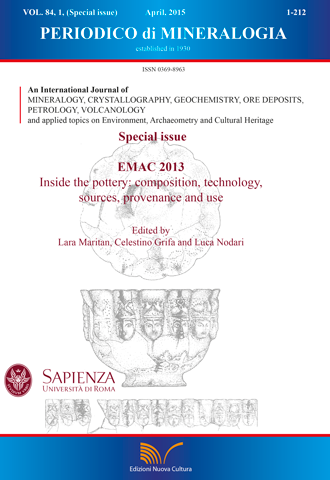Technological aspects of an early 19th c. English and French white earthenware assemblage from Bern (Switzerland)
DOI:
https://doi.org/10.2451/2015PM0009Keywords:
Creamware, Wedgwood, Creil, Niderviller, Chemistry, TechniqueAbstract
Ceramic material from the Brunngasshalde town-waste-dump of Berne, the capital of Switzerland (infilling 1787 - 1832) encompasses 9.2 % white earthenware. Only 1 % of the latter bear impressed stamps of English, French and Swiss manufactures. All stamped English (WEDGWOOD, n=3) and French (CREIL, n=2; NIDERVILLER n=1) material was analyzed by XRF, XRD, MEB-BSE and MEB-EDS. The Wedgwood pottery is rich in coarse SiO2 grains, interpreted as crushed flint fragments, with abundant signs of a high temperature treatment. They lay in a finely grained siliceous-aluminous matrix, in one specimen together with grog. The Creil material is very similar, but lacks grog. The English white earthenware has lower SiO2 (73-76 wt. %) as Creil (77-79 wt. %), similar Al2O3 (18-22 wt. %), but more K2O (ca. 1 vs. 0.4 wt. %) and Ba (200-220 ppm vs. 130 ppm). In comparison, previously analyzed early French white earthenware from Paris (n=5), produced in Pont-aux-Choux (c. 1750-1788), bearing the characteristic rice grain decoration, differs clearly in its concentrations of SiO2 (60-61 wt. %) and Al2O3 (32-34 wt. %). Creil and Wedgwood sherds must be classified as siliceous-aluminous white earthenware. The CaO-rich (17 wt.%) Niderviller fragment pertains to the calcareous white earthenware group. A comparison with 19 already published calcareous bodies from Lorraine shows similarities (crushed SiO2 grains and lead frit as temper in a fine grained siliceous aluminous matrix), but its chemical composition differs from the published analysis of an object stylistically attributed to Niderviller. White earthenware glazes from Niderviller, Paris and the Wegdwood manufacture are transparent lead alkali glazes, and from Creil lead glazes. Niderviller has a K2O rich (5 wt. %) and Wedgwood an Al2O3 rich (5-8 wt. %) glaze. Chemical elements diffused from the body to the glaze (e. g. lead) and conversely (e. g. alumina). All samples are artificial bodies, made from a white-firing clay, to which were added ground flint, calcined or not, with or without grog, or ground flint/quartz sand, calcined or not, and lead frits and chalk for the calcareous white earthenware. These results are in good accordance with old recipes. They are also the first archaeometric study of undoubtly (trademark!) Creil, Niderviller and Wedgwood tableware.


